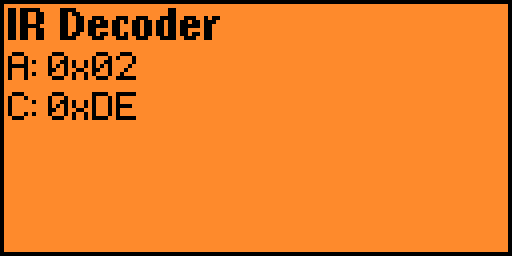Hello!
Please help me to convert IR hex code to format for Flipper Zero
Here is an example:
JVC HRS2901U VHS recorder
Power button
0000 006c 00bc 0000 0140 009f 0014 003c 0014 003c 0014 0014 0014 0014 0014 0014 0014 0014 0014 003c 0014 0014 0014 003c 0014 003c 0014 0014 0014 003c 0014 0014 0014 0014 0014 0014 0014 0014 0014 037b 0014 003c 0014 003c 0014 0014 0014 0014 0014 0014 0014 0014 0014 003c 0014 0014 0014 003c 0014 003c 0014 0014 0014 003c 0014 0014 0014 0014 0014 0014 0014 0014 0014 037b 0014 003c 0014 003c 0014 0014 0014 0014 0014 0014 0014 0014 0014 003c 0014 0014 0014 003c 0014 003c 0014 0014 0014 003c 0014 0014 0014 0014 0014 0014 0014 0014 0014 037b 0014 003c 0014 003c 0014 0014 0014 0014 0014 0014 0014 0014 0014 003c 0014 0014 0014 003c 0014 003c 0014 0014 0014 003c 0014 0014 0014 0014 0014 0014 0014 0014 0014 037b 0014 003c 0014 003c 0014 0014 0014 0014 0014 0014 0014 0014 0014 003c 0014 0014 0014 003c 0014 003c 0014 0014 0014 003c 0014 0014 0014 0014 0014 0014 0014 0014 0014 037b 0014 003c 0014 003c 0014 0014 0014 0014 0014 0014 0014 0014 0014 003c 0014 0014 0014 003c 0014 003c 0014 0014 0014 003c 0014 0014 0014 0014 0014 0014 0014 0014 0014 037b 0014 003c 0014 003c 0014 0014 0014 0014 0014 0014 0014 0014 0014 003c 0014 0014 0014 003c 0014 003c 0014 0014 0014 003c 0014 0014 0014 0014 0014 0014 0014 0014 0014 037b 0014 003c 0014 003c 0014 0014 0014 0014 0014 0014 0014 0014 0014 003c 0014 0014 0014 003c 0014 003c 0014 0014 0014 003c 0014 0014 0014 0014 0014 0014 0014 0014 0014 037b 0014 003c 0014 003c 0014 0014 0014 0014 0014 0014 0014 0014 0014 003c 0014 0014 0014 003c 0014 003c 0014 0014 0014 003c 0014 0014 0014 0014 0014 0014 0014 0014 0014 037b 0014 003c 0014 003c 0014 0014 0014 0014 0014 0014 0014 0014 0014 003c 0014 0014 0014 003c 0014 003c 0014 0014 0014 003c 0014 0014 0014 0014 0014 0014 0014 0014 0014 037b 0014 003c 0014 003c 0014 0014 0014 0014 0014 0014 0014 0014 0014 003c 0014 0014 0014 003c 0014 003c 0014 0014 0014 003c 0014 0014 0014 0014 0014 0014 0014 0014 0014 0014
See also RC: Infrared Hex Code Database: JVC HRS2901U Commands (Page 1)


